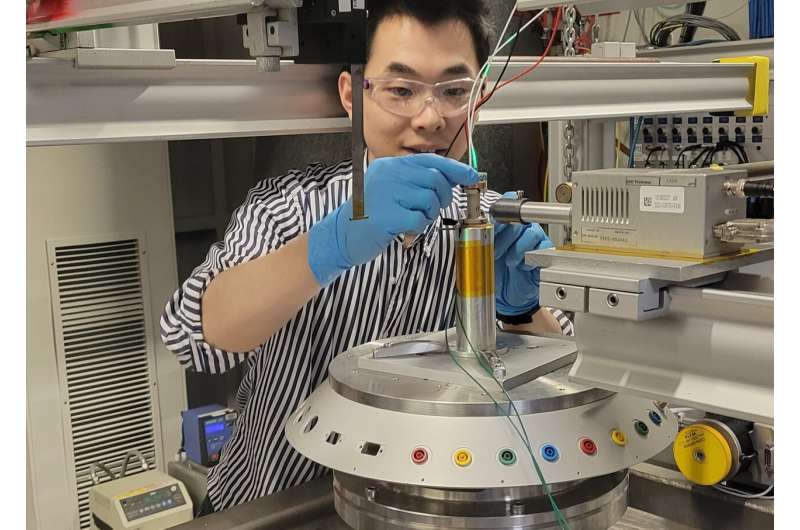This article has been reviewed according to Science X's editorial process and policies. Editors have highlighted the following attributes while ensuring the content's credibility:
fact-checked
peer-reviewed publication
trusted source
proofread
Researchers extend shelf life of electrolyzers that can convert carbon dioxide to green chemicals

An international research team at DTU has increased the shelf life of electrolyzers that convert CO2 from half a day to 100 hours. This is good news for companies working with the process. The findings were published in Nature Catalysis under the title "Identifying and alleviating the durability challenges in the membrane-electrode-assembly for high-rate CO electrolysis."
Too much CO2 in the atmosphere is one of the major culprits of global warming. But imagine if we could convert captured CO2 into valuable green chemicals—and we can. The conversion is made possible through CO2 electrolysis, but the process is complex and costly.
Researchers are now one step closer to the development of a technology that can transform captured CO2 into useful green chemicals such as ethylene and ethanol, which can be used in the production of plastic.
Most of the plastics we currently use are produced from fossil-based chemicals, which are responsible for around 5% of our global CO2 emissions. CO2 electrolysis offers a green alternative to fossil-based chemicals while also using captured CO2 as a resource. This means the technology has great potential to play a role in society's green transition.
"We have found out why and where in the chemical process of electrolysis of CO/CO2 the electrolysis device degrades. Our results provide clear guidelines for researchers and the industry on how to extend the durability of devices for CO/CO2 electrolysis, which will strengthen the commercialization of the technology," says DTU Professor Brian Seger.
Electrolysis using CO2
To understand the importance of the results, we first need to understand the principles of electrolysis. Electrolysis enables you to separate matter into its basic elements or make new chemical compounds. It is a known chemical process that takes place by adding an electric current to an electrolyte, which is a solution or molten compound that conducts electricity.
Here, the positive ions of the electrolyte will be attracted to a cathode, while the negative ions of the electrolyte will be attracted to an anode. In electrolysis of water (H2O), the anode in a water-filled electrolysis vessel will attract oxygen (O2), while the cathode will attract hydrogen (H2), splitting the water into its basic components.
The first intermediate product produced from CO2 electrolysis is CO (carbon monoxide). This is followed by a CO electrolysis, whereby the valuable chemicals ethanol (alcohol, which can be used as fuel) and ethylene (hydrocarbon, which can be used to make the plastic material polyethylene) can be produced.
Durability increased from half a day to 100 hours
CO2 electrolysis is a complex multi-step process, and several factors can affect the effectiveness of the process. A particular challenge is the breakdown of the anode in the electrolyte solution, which leads to the device failing after about half a day's use. This makes the process very costly and difficult to scale up for industrial use.
But since it is precisely the durability of the anode that the researchers have increased, there may be good news on the way for companies working with CO2 electrolysis.
The researchers have shown that one of the biggest causes of anode degradation is the production of acetate on the cathode, where the environment is alkaline. This causes acetic acid to form at the anode, thus lowering the pH. If the material on the anode cannot handle the now low pH of the electrolysis solution, it will degrade, and the electrolysis device will fail after about 12 hours' use.
By removing the acetate and thereby maintaining the pH of the electrolyte solution, the researchers have found that the durability of the anode can be extended from half a day to more than 100 hours. While the researchers achieved this by manually replacing the electrolysis solution every 12 hours when the pH became too low, a simple filter could solve this when commercialized.
"Our guidelines tell researchers and the industry that they need to monitor the pH value on the anolyte side in order to maintain a pH that does not corrode the anode. This is a simple but crucial point for the companies who are already starting to commercialize the technology," says DTU Professor Brian Seger.
More information: Qiucheng Xu et al, Identifying and alleviating the durability challenges in membrane-electrode-assembly devices for high-rate CO electrolysis, Nature Catalysis (2023). DOI: 10.1038/s41929-023-01034-y
Journal information: Nature Catalysis
Provided by Technical University of Denmark





















